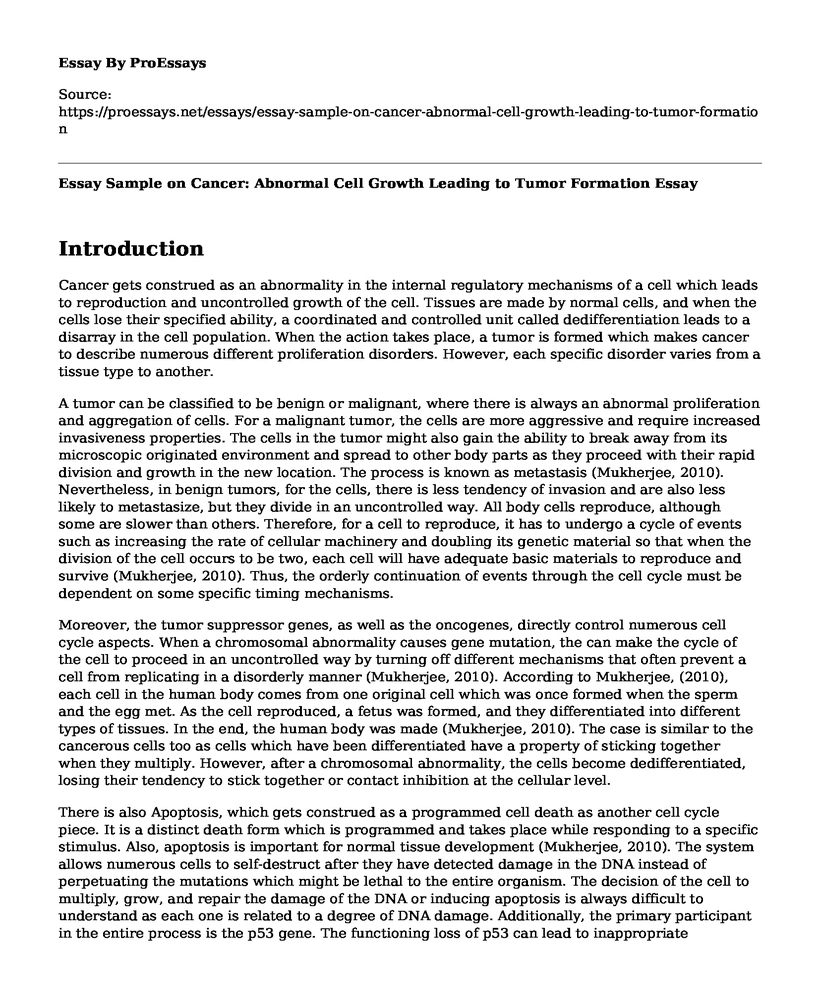Introduction
Cancer gets construed as an abnormality in the internal regulatory mechanisms of a cell which leads to reproduction and uncontrolled growth of the cell. Tissues are made by normal cells, and when the cells lose their specified ability, a coordinated and controlled unit called dedifferentiation leads to a disarray in the cell population. When the action takes place, a tumor is formed which makes cancer to describe numerous different proliferation disorders. However, each specific disorder varies from a tissue type to another.
A tumor can be classified to be benign or malignant, where there is always an abnormal proliferation and aggregation of cells. For a malignant tumor, the cells are more aggressive and require increased invasiveness properties. The cells in the tumor might also gain the ability to break away from its microscopic originated environment and spread to other body parts as they proceed with their rapid division and growth in the new location. The process is known as metastasis (Mukherjee, 2010). Nevertheless, in benign tumors, for the cells, there is less tendency of invasion and are also less likely to metastasize, but they divide in an uncontrolled way. All body cells reproduce, although some are slower than others. Therefore, for a cell to reproduce, it has to undergo a cycle of events such as increasing the rate of cellular machinery and doubling its genetic material so that when the division of the cell occurs to be two, each cell will have adequate basic materials to reproduce and survive (Mukherjee, 2010). Thus, the orderly continuation of events through the cell cycle must be dependent on some specific timing mechanisms.
Moreover, the tumor suppressor genes, as well as the oncogenes, directly control numerous cell cycle aspects. When a chromosomal abnormality causes gene mutation, the can make the cycle of the cell to proceed in an uncontrolled way by turning off different mechanisms that often prevent a cell from replicating in a disorderly manner (Mukherjee, 2010). According to Mukherjee, (2010), each cell in the human body comes from one original cell which was once formed when the sperm and the egg met. As the cell reproduced, a fetus was formed, and they differentiated into different types of tissues. In the end, the human body was made (Mukherjee, 2010). The case is similar to the cancerous cells too as cells which have been differentiated have a property of sticking together when they multiply. However, after a chromosomal abnormality, the cells become dedifferentiated, losing their tendency to stick together or contact inhibition at the cellular level.
There is also Apoptosis, which gets construed as a programmed cell death as another cell cycle piece. It is a distinct death form which is programmed and takes place while responding to a specific stimulus. Also, apoptosis is important for normal tissue development (Mukherjee, 2010). The system allows numerous cells to self-destruct after they have detected damage in the DNA instead of perpetuating the mutations which might be lethal to the entire organism. The decision of the cell to multiply, grow, and repair the damage of the DNA or inducing apoptosis is always difficult to understand as each one is related to a degree of DNA damage. Additionally, the primary participant in the entire process is the p53 gene. The functioning loss of p53 can lead to inappropriate progression via the cell cycle after the damage of the DNA as well as the survival of a cell which might have died. Therefore, since the p53 gene is at the center of apoptosis and cell cycle stability, it is always the most mutated gene in human cancers as it comprises of defects that are in more than fifty percent of all the tumors (Mukherjee, 2010).
Reference
Mukherjee, S. (2010). The emperor of all maladies: a biography of cancer. Simon and Schuster. HarperCollins Publishers. ISBN: 1439170916/978-1439170915
Cite this page
Essay Sample on Cancer: Abnormal Cell Growth Leading to Tumor Formation. (2022, Dec 29). Retrieved from https://proessays.net/essays/essay-sample-on-cancer-abnormal-cell-growth-leading-to-tumor-formation
If you are the original author of this essay and no longer wish to have it published on the ProEssays website, please click below to request its removal:
- Reflection of Nursing Knowledge
- Hazard Prevention Through Effective Safety and Health Training Paper Example
- Research Paper on Analyzing Health Information System
- Essay Sample on Costa Rica & US Health Care: A Comparative Analysis
- Evidence-Based Research in Health Care: CDC Policies & Guidelines - Essay Sample
- Essay Example on Affordable Care Act: Benefits & Impact on US Healthcare
- Essay Example on Sleep Studies in Lab Setting: Problems & Solutions







